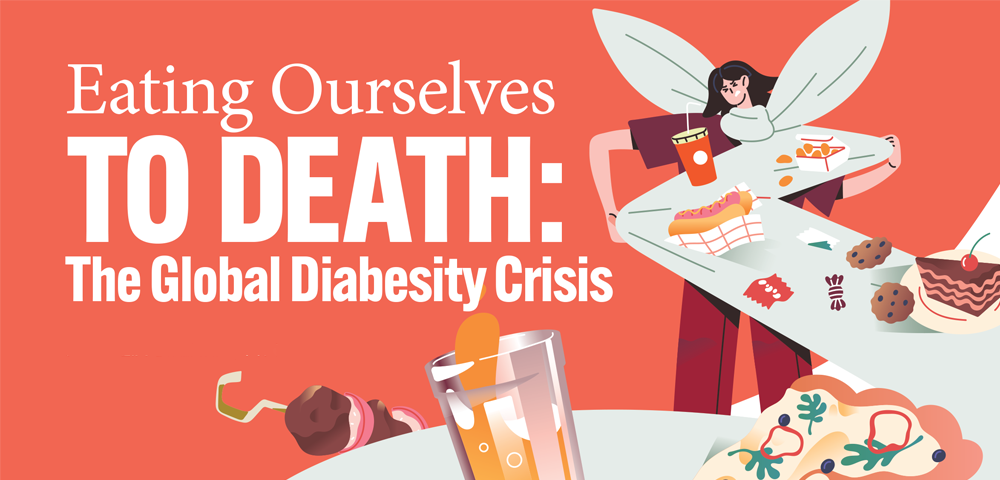
Our modern lifestyle – too much sitting, too many empty calories, and a food environment that makes healthy choices harder than ever – is fuelling the epidemic
Let’s be honest: no one binges on broccoli, veggies, or steak, but on chips, cookies, and candy for sure. They’re designed to make us overconsume, and they work. Meanwhile, today’s food supply delivers more calories and fewer nutrients, trapping many people in a cycle of being overfed but undernourished.
This crisis now has a name: “diabesity” –the dangerous overlap of obesity and type 2 diabetes. It’s no longer rare; it’s the norm. By 2040, over 642 million people are expected to have diabetes, with excess body fat as the leading driver.
Our modern lifestyle – too much sitting, too many empty calories, and a food environment that makes healthy choices harder than ever – is fuelling the epidemic.
Even more alarming, the damage may begin before birth. Studies show that children born to mothers with obesity are 2–3 times more likely to develop autism or ADHD, paralleling the rise in metabolic and neurodevelopmental disorders in the last decade.
The numbers don’t lie
In 1950, diabetes claimed around 24,000 American lives. By 2021, that number had jumped to over 100,000 – a fourfold increase. Even after adjusting for population growth, diabetes deaths have nearly doubled per capita. Despite better medications and glucose monitoring, more people are dying because medicine alone can’t fix a broken food system.
- Poor diet is now linked to one in five deaths globally.
- In the U.S., over 38 million people (about one in ten) have diabetes.
Canada mirrors this trend. What’s even more alarming is that nearly one in three adults is prediabetic – and most don’t know it!
The science of diabesity
At the core of diabesity is insulin resistance, where the body’s cells stop responding properly to insulin, forcing the pancreas to overproduce it to control blood sugar. Over time, this leads to chronically high blood sugar and type 2 diabetes.
Visceral fat, the deep belly fat around organs, releases inflammatory chemicals that block insulin and worsen metabolic health, increasing the risk of fatty liver, heart disease, and certain cancers. A 2020 review found that over 80% of people with type 2 diabetes are also obese, showing how tightly linked these conditions are.
How to reverse the trend
The good news? Type 2 diabetes is largely preventable and, in many early cases, reversible. Losing visceral fat dramatically improves insulin sensitivity and metabolic health.
The results are just as encouraging for individuals already diagnosed: losing 10–15 kg (22–33 lb) has been shown to reverse the condition in many people.
What you can do:
Eat wholefoods: Focus on vegetables, legumes, fish, nuts, and whole grains. Watch for hidden sugars in processed “health” foods.
Create a calorie deficit: Aim for a 500–750 kcal/day deficit for gradual weight loss. For faster results, short-term, very-low-calorie diets (800–1000 kcal/day) and structured meal replacements (e.g., RealEasy™ with PGX®) can help jumpstart results.
Move more: Muscle is a major site of glucose uptake. Resistance training and aerobic exercise both help reverse insulin resistance.
Prioritize sleep: Just one night of poor sleep can reduce insulin sensitivity by up to 25%.
Manage stress: Chronic stress raises cortisol, signalling your liver to release more glucose, even without eating.
Use supplementation: Berberine may rival metformin in lowering blood glucose; butyric acid supports insulin sensitivity, gut health, and inflammation; and other options, including alpha-lipoic acid, inositol, omega-3s, and vitamin D, are also helpful. If you take medications like metformin, consider vitamin B12, magnesium, and CoQ10, which can be depleted over time.
Final thoughts
Diabesity isn’t inevitable. The choices you make today – what you eat, how you move, and how you live – can change your future. Start small and take back control of your health.













